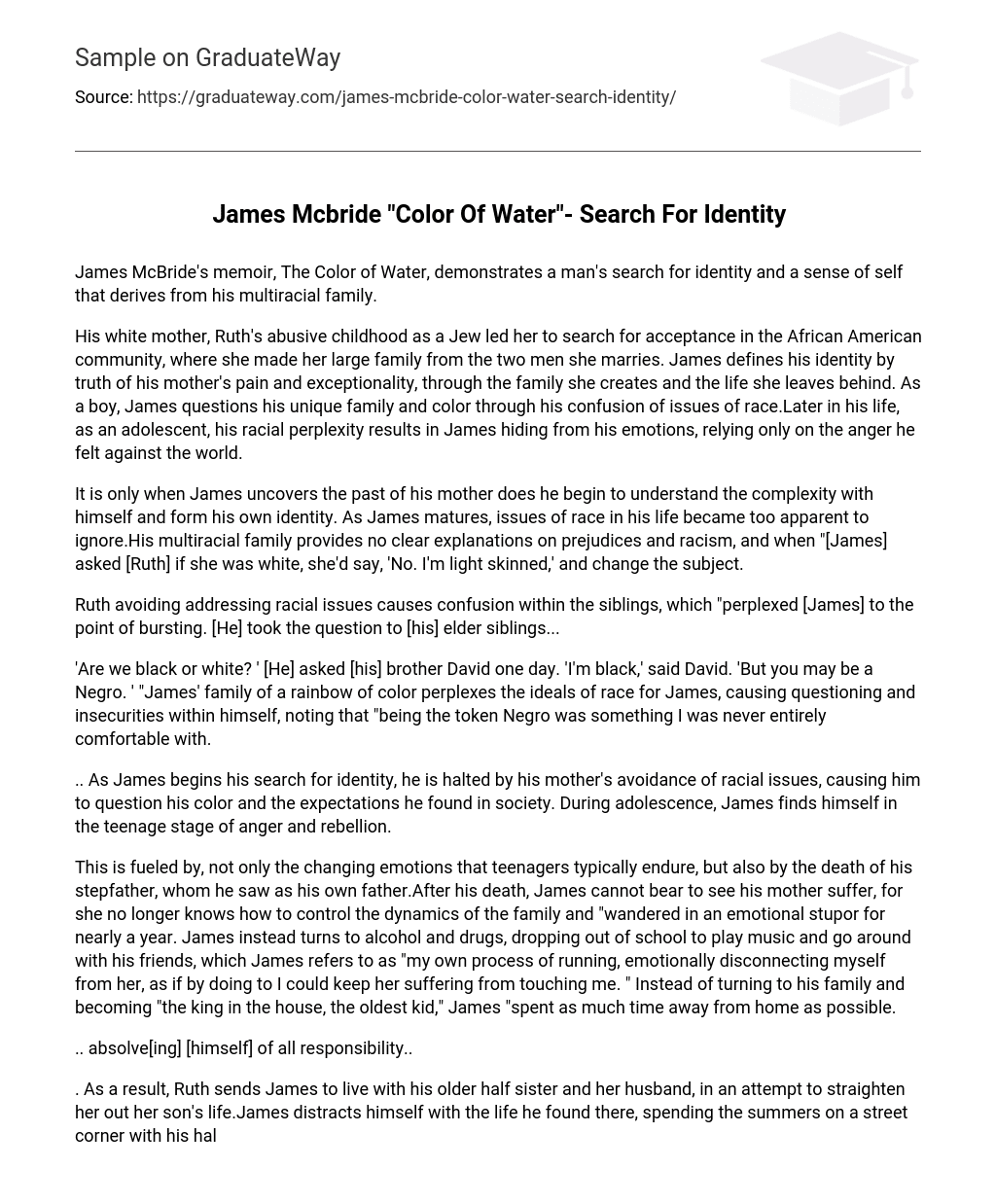James McBride’s memoir, The Color of Water, demonstrates a man’s search for identity and a sense of self that derives from his multiracial family.
His white mother, Ruth’s abusive childhood as a Jew led her to search for acceptance in the African American community, where she made her large family from the two men she marries. James defines his identity by truth of his mother’s pain and exceptionality, through the family she creates and the life she leaves behind. As a boy, James questions his unique family and color through his confusion of issues of race.Later in his life, as an adolescent, his racial perplexity results in James hiding from his emotions, relying only on the anger he felt against the world.
It is only when James uncovers the past of his mother does he begin to understand the complexity with himself and form his own identity. As James matures, issues of race in his life became too apparent to ignore.His multiracial family provides no clear explanations on prejudices and racism, and when “[James] asked [Ruth] if she was white, she’d say, ‘No. I’m light skinned,’ and change the subject.
Ruth avoiding addressing racial issues causes confusion within the siblings, which “perplexed [James] to the point of bursting. [He] took the question to [his] elder siblings…
‘Are we black or white? ‘ [He] asked [his] brother David one day. ‘I’m black,’ said David. ‘But you may be a Negro. ‘ “James’ family of a rainbow of color perplexes the ideals of race for James, causing questioning and insecurities within himself, noting that “being the token Negro was something I was never entirely comfortable with.
.. As James begins his search for identity, he is halted by his mother’s avoidance of racial issues, causing him to question his color and the expectations he found in society. During adolescence, James finds himself in the teenage stage of anger and rebellion.
This is fueled by, not only the changing emotions that teenagers typically endure, but also by the death of his stepfather, whom he saw as his own father.After his death, James cannot bear to see his mother suffer, for she no longer knows how to control the dynamics of the family and “wandered in an emotional stupor for nearly a year. James instead turns to alcohol and drugs, dropping out of school to play music and go around with his friends, which James refers to as “my own process of running, emotionally disconnecting myself from her, as if by doing to I could keep her suffering from touching me. ” Instead of turning to his family and becoming “the king in the house, the oldest kid,” James “spent as much time away from home as possible.
.. absolve[ing] [himself] of all responsibility..
. As a result, Ruth sends James to live with his older half sister and her husband, in an attempt to straighten her out her son’s life.James distracts himself with the life he found there, spending the summers on a street corner with his half sister’s husband, Big Richard, whom he adores, and the unique men that frequented the area. During these summers, James discovers “[He] could hide.
No one knew [him]. No one knew [his] past, [his] white mother, [his] dead father, nothing. It was perfect. [His] problems seemed far, far away.
Instead of facing the realities of loss and anger in his family, James seeks distractions in drugs, alcohol, and the accepting community he finds with Big Richard, thus delaying his search for a sense of self. James learns to emotionally disconnect himself from his family, which allows him to run away from becoming the responsible person his family needed him to be. Towards the end of the memoir, James achieves a sense of inner peace by discovering his identity, made through uncovering the earlier life of his mother.By reconnecting with the suffering Ruth endured, James is able to face his repressed emotions of confusion and anger that he had hid for so long.
He hits the realization that “in order to find out who I was, I had to find out who my mother was. He acknowledges that he hid from himself with a life of distractions, delaying his inevitable discovery of identity. James retorts, ” I never knew who I was.It wasn’t’ so much of a question of searching for myself as it was my own decisions not to look.
It was only when James uncovers the life of his mother does he begin to understand the complexity within himself, noting that, “the uncertainty that lived inside me began to dissipate; the ache that the little boy who stared in the mirror felt was gone. ” By uncovering Ruth’s earlier life, James could understand his own singularity, thus creating the identity he sought his life to achieve. Ruth led a life broken in two. Her later life consists of the large family she creates with the two men she marries, and her awkwardness of living between two racial cultures.
She kept her earlier life a secret from her children, for she did not wish to revisit her past by explaining her precedent years. Once he uncovered Ruth’s earlier life, James could define his identity by the truth of Ruth’s pain, through the relations she left behind and then by the experiences James endured within the family she created. As her son, James could not truly understand himself until he uncovered the truth within the halves of his mother’s life, thus completing the mold of his own identity.





